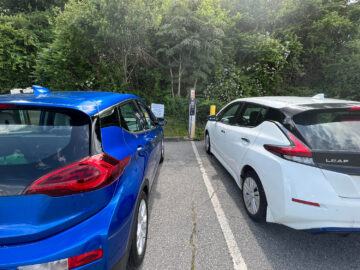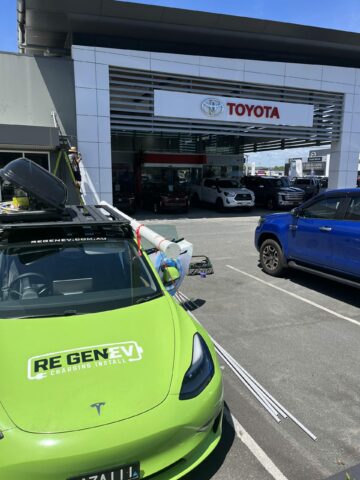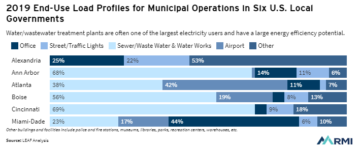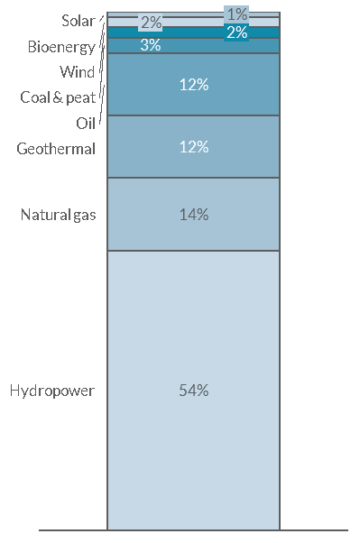Sign up for daily news updates from CleanTechnica on email. Or follow us on Google News!
I’m spending this week at the Florida Shore and Beach Preservation Association (FLSBPA) conference. It’s a tech conference, the 37th tech conference of the FLSBPA, actually, which means that scientists and engineers — coastal experts — are presenting back-to-back sessions, over several days, describing federal, state, county, and private projects to renourish US coastal beaches.
Beaches? You say. Why should I care about beaches? Well, the coastal erosion control line has receded over the decades, and, without these projects, the environmental, economic, and social ecosystems in these coastal areas would be unalterably changed.
The discussions this week of plans to renourish coastlines, the project parameters, the technology they infused, and the obstacles they overcame may be of great interest to our CleanTechnica audience. After all, it’s an opportunity to reveal what coastal municipalities are doing to mitigate shore and habitat loss, relying on state-of-the-art technology to seek the most efficacious results.
The FSBPA was organized in 1957 at a meeting of 37 local government and university leaders concerned about the growing problem of beach erosion that had virtually destroyed important resort beaches such as Miami Beach. They recognized that erosion was a statewide problem that couldn’t be handled by individual cities and counties alone. That original collegial decision making seems prescient now, with sea level rise and coastal flooding a common and disturbing occurrence across hundreds of communities.
Current State of the Beaches in St. Johns County, Stephen Hammond and Damon Douglas, St. Johns County Public Works Department, St. Augustine, FL
In this session, we met, Stephen Hammond, whose job description includes developing and managing coastal, estuarine, oceanographic, and meteorological observational programs for St. John’s County; planning and putting in place the county’s coastal plan; helping with special projects, including collaborating with outside agencies; and, helping with preparing permits and regulatory documents.
Shorelines adjacent to tidal inlets are highly dynamic landforms affected by sea level rise and fluvial sediment supply processes. Climate change is expected to have substantial physical impacts on these inlet-interrupted coasts.
But is it possible for a single project to renourish a coastline to cost $20 million? You know it, Hammond outlined. Begin with 1.1 million cubic yards (cy) of sand, plant 470,000 sea oats, toss in a whole lotta labor and equipment, and voila! The beach is extended, hundreds of endangered sea turtles have sites to lay their eggs, adjacent homes have new lives, and communities can continue to attract tourists as a central tenant of their economies.
The St. Augustine Beach Shore Protection Plan is scheduled to begin this month. About 2.5 million cy of sand will be placed for $33.5 million. The US Army Corp of Engineers (USACE), Jacksonville District, awarded a $33,573,125 contract in September, 2023 to execute a Flood Control and Coastal Emergencies (FCCE) renourish of St. Augustine Beach. The project will place approximately 2.5 million cubic yards of sand on critically eroded beaches within the city of St. Augustine Beach extending 3 miles from Anastasia State Park at the north to the vicinity of A St. at the southern end of the shoreline.
The Ponte Vedra Beach Nourishment Project will place approximately 2 million cubic yards of sand on the beaches in Ponte Vedra Beach between the Duval County line to the north and the Guana Tolomato Matanzas National Estuarine Research Reserve to the south. Sand will be brought in to construct a dune and berm system throughout the project area. The renourish project will dredge sand from the permitted offshore borrow site out in federal waters and pump it onto the beach with large pipes, where it will be shaped by into position by heavy equipment. This renourish project will enhance the dune system by adding sand at the seaward edge of the existing dune, planting over a million sea oats and other varieties of supporting vegetation, and creating a more uniform front to the dune system within the project area.
Porpoise Point Drive Armoring Project consists of the installation of approximately 172 linear feet steel sheet pile with reinforced concrete cap and additional revetment. The seawall will cross the eastern end of Porpoise Point Drive and tie into an existing seawall to the south and existing rock revetment to the north.
Embassy Suites, St. Augustine Beach, Florida, Shoreline Protection and Seawall Replacement, Jonathan Brumfield, P.E., Taylor Engineering, Inc., Jacksonville, FL
The old Beachfront Hotel, which started as a Sheraton in 1974, was collapsing into the beach before the property was sold and the old hotel was demolished in 2014. In 2018 the Embassy Suites Hilton St. Augustine was opened, and the surf spray below the resort pool was a magnet for tourists. By 2022, Hurricane Ian slammed Florida and revealed that the seawall had advanced corrosion, displaced granite armor stone, caused severe erosion, and broken tiebacks — together, these were indicators of imminent failure, which would eventually take the waterfront with it.
Jonathan Brumfield described the Shore Protection and Seawall Replacement project, which was designed to enhance the waterfront to be resilient against storm events, in keeping with the architecture and aesthetics of the resort’s waterfront. Wave overtopping/ flooding, sea level rise, and functionality pointed to the need to raise the current seawall 4 feet and 600 ft long, to include a pedestrian walkway and an upland wall. One obstacle was to do the construction while the oceanfront resort was in operation; silent press-in equipment that had no vibration was brought in. Unburying 1960s debris to 16 ft deep under the original sea wall meant that excavation equipment was also needed. A compaction program to mitigate consolidation and a mesh reinforcement in the walkway slab, among other items, were added to the project. Concrete design considerations included high wave loads and chloride intrusion, resulting in silica fume concrete. The walkway features included pigmented concrete with tabby finish, mesh rebar, and fiber mesh.
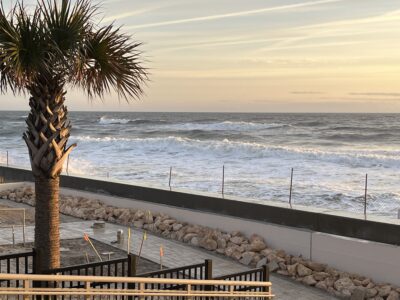
South Ponte Vedra Beach Dune Restoration Project 2022 Construction Phase, Riggs Brusnighan, Atkins NA, Inc., Jacksonville, FL
This 2022 dune restoration project resulted from initial damages from Hurricane Matthew in 2016 and was later identified as a critically eroded beach.
The dredge from the offshore borrow area was to be transported and pumped onto the beaches, Brusnighan explained, approximately 8 miles east of the target location. There were 5 submerged pipeline corridors and 2 staging areas. Dune crest or backslope needed to be tied variously to the seawall dune backslope, the escarpment, the vegetated dune, and/ or the dune shift. The trailing suction hopper dredges alternately pumped and transported 788,000 cy of sand, or 363 loads. 609,000 units of dune plants and 2750 ft of post and rope were installed to protect the dunes. Due to the prominent residential area of the dune restoration, easements for all beachfront properties were required. Constant water observations for turbidity were conducted. Environmental monitoring for marine turtles and shorebirds was completed daily; any nests were relocated to a protection area.
“Plans for tomorrow were made last week.” This mantra was the key to this project’s success, noted Brusnighan.
Have a tip for CleanTechnica? Want to advertise? Want to suggest a guest for our CleanTech Talk podcast? Contact us here.
Latest CleanTechnica TV Video
[embedded content]
I don’t like paywalls. You don’t like paywalls. Who likes paywalls? Here at CleanTechnica, we implemented a limited paywall for a while, but it always felt wrong — and it was always tough to decide what we should put behind there. In theory, your most exclusive and best content goes behind a paywall. But then fewer people read it!! So, we’ve decided to completely nix paywalls here at CleanTechnica. But…
Thank you!
Advertisement
CleanTechnica uses affiliate links. See our policy here.
- SEO Powered Content & PR Distribution. Get Amplified Today.
- PlatoData.Network Vertical Generative Ai. Empower Yourself. Access Here.
- PlatoAiStream. Web3 Intelligence. Knowledge Amplified. Access Here.
- PlatoESG. Carbon, CleanTech, Energy, Environment, Solar, Waste Management. Access Here.
- PlatoHealth. Biotech and Clinical Trials Intelligence. Access Here.
- Source: https://cleantechnica.com/2024/02/08/why-you-should-care-about-projects-to-replenish-renourish-us-coastal-beaches/
- :has
- :is
- :where
- ][p
- $UP
- 000
- 1
- 125
- 15%
- 16
- 2%
- 2014
- 2016
- 2018
- 2022
- 2023
- 300
- 36
- 4
- 400
- 5
- 8
- a
- About
- across
- actually
- added
- adding
- Additional
- adjacent
- advanced
- Advertise
- affected
- Affiliate
- After
- against
- agencies
- All
- alone
- also
- always
- among
- an
- Anastasia
- and
- any
- approximately
- architecture
- ARE
- AREA
- areas
- Army
- AS
- Association
- At
- attract
- audience
- awarded
- BE
- Beach
- Beaches
- before
- begin
- behind
- below
- BEST
- between
- Bit
- borrow
- Broken
- brought
- but
- by
- CAN
- cap
- care
- caused
- central
- change
- changed
- chip
- Cities
- City
- cleantech
- Cleantech Talk
- Climate
- Climate change
- CO
- coastal
- collaborating
- Common
- Communities
- Companies
- Completed
- completely
- concerned
- concrete
- conducted
- Conference
- considerations
- consists
- consolidation
- constant
- construct
- construction
- content
- continue
- contract
- control
- Corp
- corrosion
- Cost
- county
- Creating
- Cross
- cubic
- Current
- daily
- Days
- decades
- decide
- decided
- decision
- Decision Making
- deep
- Department
- described
- describing
- Design
- designed
- destroyed
- developing
- discussions
- displaced
- district
- do
- documents
- doing
- don
- douglas
- drive
- due
- Dune
- dynamic
- e
- East
- eastern
- Economic
- economies
- Ecosystems
- Edge
- Eggs
- embedded
- end
- Engineering
- Engineers
- enhance
- environmental
- equipment
- events
- eventually
- EXCAVATION
- Exclusive
- execute
- existing
- expected
- experts
- explained
- extended
- extending
- Failure
- Features
- Federal
- Feet
- felt
- fewer
- finish
- flood
- florida
- For
- from
- front
- FT
- Goes
- Government
- great
- Growing
- Guest
- had
- hammond
- handled
- Have
- heavy
- help
- helping
- here
- High
- Hilton
- Homes
- hotel
- HTML
- http
- HTTPS
- Hundreds
- hurricane
- i
- identified
- if
- Impacts
- implemented
- important
- in
- Inc.
- include
- included
- includes
- Including
- Indicators
- individual
- infused
- initial
- installation
- installed
- interest
- into
- IT
- items
- johns
- jonathan
- jpg
- keeping
- Key
- Know
- labor
- large
- Last
- later
- lay
- leaders
- Level
- like
- likes
- Limited
- Line
- linear
- links
- Lives
- loads
- local
- Local Government
- location
- Long
- loss
- made
- Making
- managing
- Mantra
- Marine
- matthew
- max-width
- May..
- means
- meant
- Media
- meeting
- mesh
- met
- Miami
- million
- Mitigate
- monitoring
- Month
- more
- most
- Municipalities
- National
- Need
- needed
- New
- news
- no
- North
- noted
- now
- observational
- observations
- obstacle
- obstacles
- occurrence
- of
- Old
- on
- ONE
- onto
- opened
- operation
- Opportunity
- or
- original
- Other
- our
- out
- outlined
- outside
- over
- parameters
- Park
- People
- permits
- phase
- physical
- pipeline
- pipes
- Place
- placed
- plan
- planning
- plans
- plant
- Planting
- plants
- plato
- Plato Data Intelligence
- PlatoData
- player
- podcast
- Point
- policy
- pool
- position
- possible
- Post
- preparing
- presenting
- preservation
- private
- Problem
- processes
- Program
- Programs
- project
- projects
- prominent
- properties
- property
- protect
- protection
- public
- publish
- pump
- put
- Putting
- raise
- Read
- Reader
- recognized
- regulatory
- Relocated
- relying
- replacement
- replenish
- required
- research
- Reserve
- residential
- resilient
- Resort
- restoration
- resulted
- resulting
- Results
- reveal
- Revealed
- Rise
- Rock
- SAND
- say
- scheduled
- scientists
- SEA
- Sea level
- see
- Seek
- seems
- September
- session
- sessions
- several
- severe
- shaped
- sheet
- shift
- should
- single
- site
- Sites
- So
- Social
- sold
- South
- Southern
- special
- Spending
- st
- staging
- State
- state-of-the-art
- steel
- Stephen
- STONE
- Stories
- Storm
- substantial
- success
- such
- suggest
- supply
- support
- Supporting
- surf
- system
- T
- tabby
- Take
- Talk
- Target
- taylor
- team
- tech
- Technology
- tenant
- that
- The
- their
- then
- theory
- There.
- These
- they
- this
- this week
- throughout
- TIE
- Tied
- tip
- to
- together
- tomorrow
- toss
- tough
- transported
- tv
- under
- units
- university
- Updates
- Upland
- us
- us army
- uses
- Ve
- vegetation
- Video
- virtually
- Wall
- want
- was
- Water
- Waters
- Wave
- we
- week
- WELL
- were
- What
- which
- while
- WHO
- whole
- whose
- why
- will
- with
- within
- without
- works
- would
- write
- Wrong
- you
- Your
- youtube
- zephyrnet



